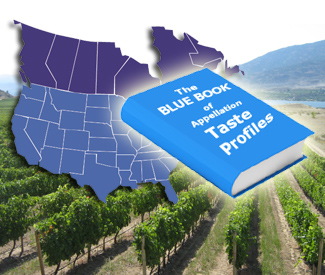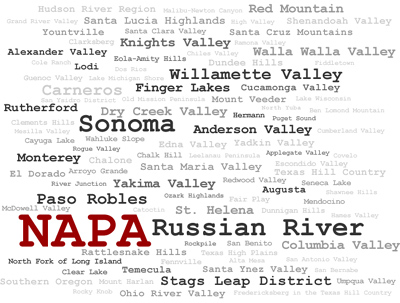

It's all about finding and cataloging diversity
Best-of-Appellation™ Evaluation:
Seeing the Need, Part II
Branding Diversity
In Part I, we traced the development of a rich and diverse wine culture in North America over the past four decades. That has been an amazing achievement, considering the fact that for consumers and producers alike it all happened under the glass ceiling of vestigial prohibitionism.
by
Roger Dial
October 28, 2008
Meanwhile, Back at the Disconnect…
Let’s begin with the sixty-four dollar question about the future prospects of our industry. Do we have the marketing paradigm and branding vehicles to effectively represent what has been built over the past four decades?
The rich diversity, evident in every one of the parameters we’ve highlighted in Part I, should be the basis of optimism about the future of the North American wine industry. The “shape,” speaking both figuratively and literally, of the current wine culture, on both the producer and consumer sides, promises a quantum leap forward in finally legitimizing and expanding the place of wine in North America.
However, what has not developed along with this growth by diversification is an understanding and a means to market this cornucopia of diversity. The richness of our viticultural diversity is grossly under utilized, and in many ways mis-marketed, as if diversity of product and consumer tastes were the problem, not the opportunity to grow the market.
Let’s look at what has happened on the marketing front…or not happened…in parallel to the diversification on the producer and consumer fronts of our burgeoning wine culture?
Branding, itself, is composed of three key functions:
1.) Differentiation: this has been called “niche-creation”; a process of building a foundation of identity for the product or commodity group by distinguishing it from other products, while at the same time enhancing its identity by associating it with similar products.
2.) Characterization: this is the business of putting meat on the bone of product identity; identifying and conceptually packaging the virtues and utilities (hopefully real ones, not just spin) of a given product or commodity group in such form as to create and sustain consumer recognition, expectation and satiation.
3.) Validation: that is, quality validation rendered with authority, fairness, and credible detachment.
So, how have we gone about the branding of North American wine over the past four decades?
However, inherent in the decision to choose varietalism (rather than regionality) as the baseline of differentiation was the future reductionism that could be expressed as a cab is a cab is a cab.
We know this isn’t right…that a Cabernet Sauvignon from one region probably doesn’t taste just like a Cabernet Sauvignon from an ecologically different region. But, so far, there is no vehicle for systematically differentiating the distinctive effect that region has on variety; and as a consequence the most basic niche sorting, consistent with the real structure of the industry, remains to be done.
Also, early on we adopted a “noble variety” stratification system of differentiation, focused on the varieties associated with the “best” regions of Europe (notably Bordeaux and Burgundy). Ironically, this top-level component of branding was done out of the regional context within which European varietal stratification was developed over many years of trial and error. Simply put, in differentiating/stratifying grape varietals we assumed that:
Chardonnay was prima facia a “noble” variety
as distinct from:
Chardonnay was noble IN and/or BECAUSE of the Chablis and Meursault terroir
and those particular regional winemaking traditions
The effect of this reductionist stratification has been, all too often, to mismatch so-called “noble” varieties to diverse terroir in pushing out the frontiers of North American viticulture, as was even evidenced in the rapid plantation of Monterey County, the largest ever viticultural development in North America.
Furthermore, premature varietal stratification has hamstrung and stigmatized the differentiated brand development of dozens upon dozens of interesting and terroir-suited grape assets in a catalog now exceeding 300 varieties. The bizarre logic here seems to boil down to a notion that “this variety is no good for growing here because it wouldn’t make a good wine there (notably Medoc or Burgundy)”.

The “Napa” brand is the model of place-identity differentiation. The same could be had for many of the other 189 formally differentiated AVAs in the US…with the right marketing agenda.
One thinks immediately of the Napa Valley AVA as having a distinct appellation identity…that is, of having successfully achieved the first level of branding – differentiation. Whether a person knows anything substantively (characterization) about these wines, who hasn’t heard of the Napa Valley?
Patriotic Napa producers, understandably, may prefer the mysterious “creationist” explanation of their distinctive identity…“Napa enjoys and profits from a distinct place-identity because God made Napa the best place to grow wine grapes.” But let’s not confuse the works of man and God. Put simply, some very wise men got started early differentiating, then characterizing and validating the Napa Valley region and its products.
The Napa Valley AVA is not a miracle, it’s a model. This kind of place-identity building (i.e. differentiation) can and should happen with every winegrowing appellation that has a serious marketing agenda. The point is that it hasn’t happened, despite the fact that we are now nearly three decades into the formal/legal AVA differentiation process. Differentiation on the ground and in law has already happened; now it needs to happen in the mind and in the marketplace.
Pa
Let’s begin with the sixty-four dollar question about the future prospects of our industry. Do we have the marketing paradigm and branding vehicles to effectively represent what has been built over the past four decades?
The rich diversity, evident in every one of the parameters we’ve highlighted in Part I, should be the basis of optimism about the future of the North American wine industry. The “shape,” speaking both figuratively and literally, of the current wine culture, on both the producer and consumer sides, promises a quantum leap forward in finally legitimizing and expanding the place of wine in North America.
However, what has not developed along with this growth by diversification is an understanding and a means to market this cornucopia of diversity. The richness of our viticultural diversity is grossly under utilized, and in many ways mis-marketed, as if diversity of product and consumer tastes were the problem, not the opportunity to grow the market.
Let’s look at what has happened on the marketing front…or not happened…in parallel to the diversification on the producer and consumer fronts of our burgeoning wine culture?
Branding
Every commodity, and every product within a commodity group, needs to be strategically marketed; and, as we all know, the key to successful marketing of any product is branding.Branding, itself, is composed of three key functions:
1.) Differentiation: this has been called “niche-creation”; a process of building a foundation of identity for the product or commodity group by distinguishing it from other products, while at the same time enhancing its identity by associating it with similar products.
2.) Characterization: this is the business of putting meat on the bone of product identity; identifying and conceptually packaging the virtues and utilities (hopefully real ones, not just spin) of a given product or commodity group in such form as to create and sustain consumer recognition, expectation and satiation.
3.) Validation: that is, quality validation rendered with authority, fairness, and credible detachment.
So, how have we gone about the branding of North American wine over the past four decades?
Differentiation (by Variety)
Back in the late 60s and early 70s the industry opted to pursue a course of differentiating product by grape variety (rather than pursuing the traditional regionalized differentiation approach of Europe). It seemed like a good idea at the time, a way of distancing ourselves from the totally bogus use of European regional names to distinguish generic styles of North American wine. And, on the surface of it, one might think that either the regional or varietal branding typologies would have accommodated and exploited the rich diversity that was to be forthcoming in the explosion of winegrowing right across the continent.However, inherent in the decision to choose varietalism (rather than regionality) as the baseline of differentiation was the future reductionism that could be expressed as a cab is a cab is a cab.
We know this isn’t right…that a Cabernet Sauvignon from one region probably doesn’t taste just like a Cabernet Sauvignon from an ecologically different region. But, so far, there is no vehicle for systematically differentiating the distinctive effect that region has on variety; and as a consequence the most basic niche sorting, consistent with the real structure of the industry, remains to be done.
Also, early on we adopted a “noble variety” stratification system of differentiation, focused on the varieties associated with the “best” regions of Europe (notably Bordeaux and Burgundy). Ironically, this top-level component of branding was done out of the regional context within which European varietal stratification was developed over many years of trial and error. Simply put, in differentiating/stratifying grape varietals we assumed that:
as distinct from:
Chardonnay was noble IN and/or BECAUSE of the Chablis and Meursault terroir
and those particular regional winemaking traditions
The effect of this reductionist stratification has been, all too often, to mismatch so-called “noble” varieties to diverse terroir in pushing out the frontiers of North American viticulture, as was even evidenced in the rapid plantation of Monterey County, the largest ever viticultural development in North America.
Furthermore, premature varietal stratification has hamstrung and stigmatized the differentiated brand development of dozens upon dozens of interesting and terroir-suited grape assets in a catalog now exceeding 300 varieties. The bizarre logic here seems to boil down to a notion that “this variety is no good for growing here because it wouldn’t make a good wine there (notably Medoc or Burgundy)”.
Differentiation (by Region)
The reductionist dynamics in brand differentiating grape varieties applies, as well, to differentiating winegrowing regions. Of the 211 officially designated AVA & DVA winegrowing regions of the US and Canada, only a handful have received the most rudimentary place-brand identity.
The “Napa” brand is the model of place-identity differentiation. The same could be had for many of the other 189 formally differentiated AVAs in the US…with the right marketing agenda.
One thinks immediately of the Napa Valley AVA as having a distinct appellation identity…that is, of having successfully achieved the first level of branding – differentiation. Whether a person knows anything substantively (characterization) about these wines, who hasn’t heard of the Napa Valley?
Patriotic Napa producers, understandably, may prefer the mysterious “creationist” explanation of their distinctive identity…“Napa enjoys and profits from a distinct place-identity because God made Napa the best place to grow wine grapes.” But let’s not confuse the works of man and God. Put simply, some very wise men got started early differentiating, then characterizing and validating the Napa Valley region and its products.
The Napa Valley AVA is not a miracle, it’s a model. This kind of place-identity building (i.e. differentiation) can and should happen with every winegrowing appellation that has a serious marketing agenda. The point is that it hasn’t happened, despite the fact that we are now nearly three decades into the formal/legal AVA differentiation process. Differentiation on the ground and in law has already happened; now it needs to happen in the mind and in the marketplace.
Characterization: (Regions x Varieties)
If reductionism, flying in the face of both producer and consumer diversification, has marked the differentiation function of branding in the wine culture over the past forty years, the same must be said for product characterization.Pa










 READER FEEDBACK: To post your comments on this story,
READER FEEDBACK: To post your comments on this story,





